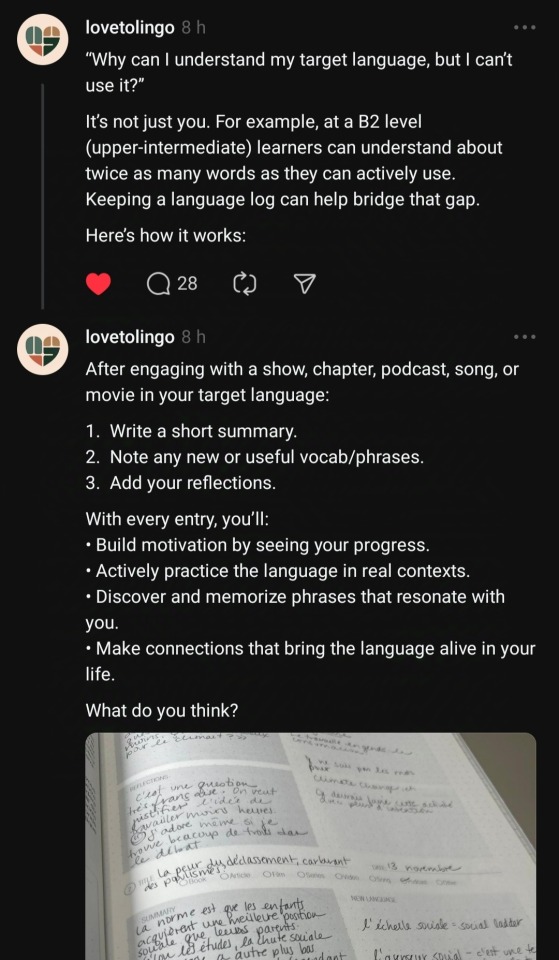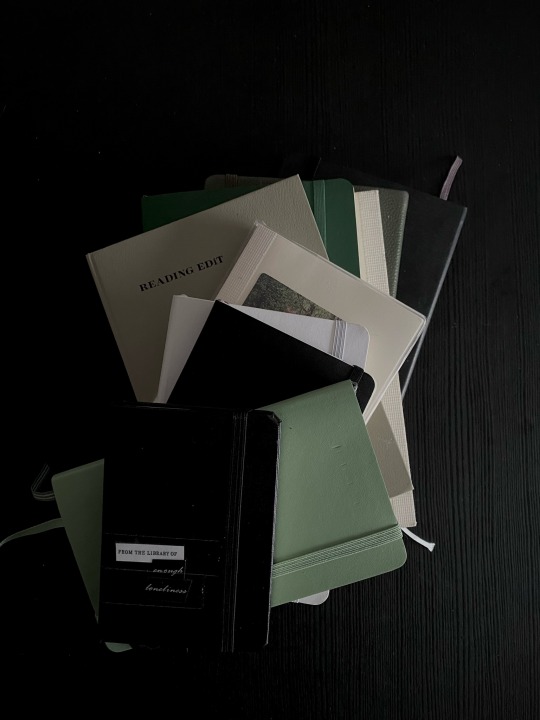#language study
Explore tagged Tumblr posts
Text
JLPT N5 - あげる
At its simplest, あげる means “to give”. At the N5 level, it’s used for giving physical things such as presents, money, water (to plants), food (to pets), etc. There is another way it can be used, but that is for a later JLPT level. For now, let’s get into ONE of the ways you can talk about giving in Japanese.
First, here is the vocabulary for this post.

【The Grammar of あげる】
Basically there are 4 parts to every あげる sentence that you should be thinking about. The first 3 are marked with particles and the last part is the verb.

Here is an example sentence:
① 【けんじは】【トムに】【腕時計を】あげた。
= As for Kenji, to Tom, a watch gave
= Kenji gave Tom a watch.
In a sentence like #1 it’s easy to see the 3 parts clearly marked with particles and then the verb at the end. Unfortunately you WILL NOT always see simple sentences like this, so let’s look at each part one by one, along with the cultural context behind あげる.
【The Giver】
Most of the time, the giver will be marked by the は (or sometimes the が) particle. This is because あげる sets up the action of giving from the giver’s perspective.
Sometimes, it is obvious who the giver is, so that phrase can be completely left out of the sentence.
② 【会社の人たちに】【お土産を】あげると思う。
= to the people at (my) company, souvenirs will give I think
= I think I’m going to give the people at my company souvenirs.
In this sentence it would be clear that the speaker is the giver. Therefore it’s not necessary to include a 私は phrase.
【The Relationship Between Giver and Receiver】
Before we move on, let’s get into a very big cultural difference between Japan and English-speaking cultures. When you use あげる, you have to think about the relationship between the giver and the receiver. In English, this doesn’t affect the words we use, but in Japanese it is actually very important when it comes to word choice. Take a look at this image:

The green circle would include close friends, family, your lover, etc. Pets and plants would also fall into this circle. Outside of the green circle are strangers, teachers, professors and depending on your job, your customers. This is because showing respect is directly connected to setting up a kind of psychological distance. You have to work hard and gain trust before you are moved into the green circle.
Some people, like coworkers and bosses, may be inside the green circle in some situations, but outside of it in other situations! A common example is when you go out drinking with coworkers. As the alcohol flows throughout the night you’ll notice that psychological space slowly disappearing - that is until the next day at work. They might act like the person you drank with was a COMPLETELY different person!
This way of thinking is called うちそと, and can be a very difficult part of Japanese culture for many foreigners. Here’s the thing: the culture of うちそと extends to the concept of giving as well.
【Giving Culture and あげる】
When it comes to giving, there are 4 situations where it’s appropriate to use the verb あげる:
① When you give something to someone inside your inner circle
② When you give something to anyone outside your inner circle
③ When someone in your inner circle gives something to someone outside your inner circle
④ When someone outside your inner circle gives something to another person outside your inner circle
Numbers 1-3 can be described as the act of giving while moving from a smaller circle to a bigger circle. Number 4 can be described as giving that doesn’t happen in your inner circle.

There are of course more possibilities when it comes to giving (and receiving). However, those situations won’t use the verb あげる!
【What Is Being Given】
In most sentences, whatever is being given is very simply marked with the を particle. However, there are times when the を particle or the positioning of what is being given will change. Take a look at these three example sentences:

Example 3a is the “default version”. The doll is marked with the を particle so we immediately know that it will be given to someone (the section manager’s wife).
For example 3b I want you to imagine that you are in a souvenir shop. You’ve bought a couple of things already, but you haven‘t decided which gifts will go to whom. All of a sudden, you see a doll that catches your eye. You immediately think to yourself, “that doll is perfect for the section manager’s wife”. Putting the item being given (that is, the doll) at the head of the sentence shows that 1) you are putting the focus of your sentence on that item and 2) there is a kind of impulsiveness to the giving. It’s kind of an instant decision.
Compare that with example 3c. Now I want you to imagine that you are in your house. You bought a bunch of dolls but you haven’t decided which one will go to whom. You pick up one of them and after some thought you say, “Ok I’ll give THIS one to the section manager’s wife.” Marking the doll with は serves to emphasize that there are several dolls, but you are highlighting one of them for a specific reason. It also shows that it WAS NOT an instant decision; some thought went into your decision.
This kind of distinction takes a really long time to understand and really “feel” but I hope that by explaining it to you now, it might stay with you somewhere deep inside your mind. You might even experiment with using sentences like 3b and 3c and surprise your Japanese friends!
【Alternative Verbs】
Lastly, let’s talk about your choice of verbs. You can actually adjust the level of “closeness” that the reader / listener feels by changing the verb that you use! あげる, あげた, あげます, あげました, etc. is used for a “default” level of closeness.
However, if the receiver is someone in a higher social position (for example a professor, a doctor, a boss, a politician, etc.) you would instead use the similar verb さしあげる. This verb actually serves to humble yourself - and thus elevates the listener / reader.
④ 【この本は】ただでさしあげます。
= as for this book, for nothing will give
= I will give you this book for free.
From this sentence you can tell that the giver and the receiver are on different levels, socially. (This is a little different than うちそと.) The listener will feel an elevated level respect simply by hearing the さしあげる verb.
On the other hand, if the receiver is someone VERY close to you, you can show that closeness by using the verb やる instead of あげる. やる is often used with pets and plants.
⑤ 【彼女は】【犬に】【えさを】やるのを忘れた。
= as for her, to (her) dog food giving forgot
= She forgot to give her dog food.
As it turns out, this is why I keep on saying “what is given” instead of “a present” or “a gift”. Giving water to plants or food to pets is not a present or a gift.
Here is a visual representation of the 3 different verbs that you can use when talking about giving (from the giver’s perspective):

Here is 1 last example:

= as for apples I give to you, there are none
= I don’t have any apples to give you.
As you can see in #6, it’s possible to state a giver, a receiver and then あげる in order to describe what is being given. Once you do that, you will then have a topic which you can then go on to make a comment about!
【Conclusion】
So there you have it! あげる and its related verbs (さしあげる and やる) all express the idea of giving from the giver’s perspective. However, you have to keep the Japanese concept of うちそと in mind. Later we’ll talk about giving but from the receiver’s perspective. Stay tuned!
Rice & Peace!
-AL (アル)
👋🏾
#日本語#japanese studyblr#japanese grammar#japanese language#isshonihongo#japanese culture#あげる#jlptn5#jlpt#japanese#learn japanese#japanese lesson#japanese study#studying japanese#japaneselessons#learnjapanese#japanese langblr#japanese vocab#japanese vocabulary#language#languages#language study#language studyblr#language blr#日本語の勉強#にほんご
55 notes
·
View notes
Text




oh september, how you have my heart.
#academia#autumn#fall#season#school#university#books#books and coffee#bookshop#moodboard#aesthetic#september#dark academia#academia aesthetic#dark academia aesthetic#reading#poetry#quote#coffee#dA#haunted#beautiful#orange#red#classic academia aesthetic#literature#classics#classic academia#language study
4K notes
·
View notes
Text


coffee + ancient greek ˖˚⊹ ꣑ৎ (or pics from study sessions that i never posted)
#studyblr#study blog#studying#studyinspo#studyspo#ancient greek#study motivation#uni studyblr#dark academia#study aesthetic#study inspiration#study inspo#study movitation#uniblr#langblr#ancient greek language#language blr#language learning#language study#student life#uni life#uni student#university student
2K notes
·
View notes
Text

I very much agree with these suggestions. Forcing myself to write was the way I could finally start to become an active rather than a passive user of the target language.
2K notes
·
View notes
Text

#books and literature#books and reading#studyspo#french#japanese#language study#study#study aesthetic#studying#study blog#study motivation#studyblr#reading#education#dark academia#light academia#pink academia#cute#langblr#langblog#motivation#relatable
1K notes
·
View notes
Text
"Irish is a dead language" "no one uses irish anymore" you can pry this language from my cold dead hands. It's not dead and if it was I would still love it (my ancient greek and latin homies know what's up)
Is breá liom ag caint gailege agus ní féidir leat stad mé <33
#irish#irish langblr#irish language#gaeilge#irish history#langblr#languageblr#language learning#language study
423 notes
·
View notes
Text




Wednesday / Thursday
Third coffee of the day with a friend, which led to late night rendering in photoshop, early morning mandarin study, and evening walk.
#nyc#new york#architecture student#studyblr#fypage#university student#dark academia#coffeehouse#coffee#sunset#nyc spring#mandarin#study inspo#student life#language study#architecture rendering
258 notes
·
View notes
Text
Look, I knew five languages by age 19 and now I am learning like 3 more. I work as a language instructor and a consultant. If I can give language learners only one advice, this is it.
STOP LEARNING WORDS ON THEIR OWN.
You're doing yourself a disservice by learning lists of "30 words you must know!" "100 most common words!" like it literally means nothing if you cannot use those words in an appropriate context with proper grammar. So what you actually need to do is learn those words via example sentences.
Of course, sentences have more words so you may think you're learning less but you're actually learning the way to use it in context. That's what's important.
Language is about communication, which also means if you want to learn languages, you have to observe how people communicate with each other universally. Native speakers never have a list of words they know and they don't count every single new word they've learned. So why are you doing it to yourself? What native speakers do is listen to the new word, remember the context they're spoken in, and keep using that word in that context. And that's why people go "wait, you can use that word LIKE THAT?" all the time. So you, a language learner, are also allowed to do that. I'm not even saying those word lists are useless but they're the most useful AFTER you've known most of them and are trying to go over them for practice etc. Native speakers do click on those word lists to check out how many words they don't know or to remind themselves of those words or to learn some facts about each word. That should be your goal as well.
Learn sentences. Learn them in context. Do not fall into the "I must know xx amount of words or I'm a failure at language learning" trap perpetuated by bloggers or youtubers or whatever. Have fun with it!
#language learning#studyblr#langblr#100 days of productivity#chinese studyblr#japanese studyblr#korean studyblr#how to learn#learning#academia#academic#academics#language study#language#languages#study tip#study#study motivation
959 notes
·
View notes
Note
Kind of a random question not about art, but about your Japanese.
Are you self-taught or did you take some sort of classes and how much did it take you to get to the lvl you're at?
If you'd be comfortable with sharing some info on that, that'd be great 💗 It's just, I dunno, very impressive to me that you have enough skill to understand media in that language and it's something that'd be very useful to me too, so I'm just gathering information :3 I don't know if that makes sense lol
Oh god you can't imagine for how long I've been meaning to answer this ask, it was constantly floating at the back of my head
I'm self-taught! I didn't take any actual Japanese lessons and have been seriously studying it for around a little over 2 years (started around the end of 2022 I think??)
I had a huge weeb phase back in middle school where I'd watch like 10 episodes of naruto per day which caused me to quickly develop an ear for Japanese and I was able to understand most of the simple sentences I heard.
Around the end of 2022 I decided I wanted to learn how to read it too (mostly so that I can have more access to Japanese yandere content) and used duolingo to quickly memorize hiragana and katakana.
As many of you are probably aware duolingo is NOT good when it comes to learning kanji though, so after experimenting with a few different apps and sites, around the start of 2023 I settled on WaniKani which is an amazing site for kanji and vocabulary learning.
I was having a lot of fun studying Japanese so after a few months I decided to try my chance at that year's JLPT N3 and actually managed to pass it. With that boost I signed up for 2024's N2 and passed it too.
Here are a few apps and youtube channels that personally helped me a lot with studying:



Nihongo no Mori
Japanese with Yuka
121 notes
·
View notes
Text
Rare Language Learning: Polari
If you have ever used the words:
- Naff
- Butch
- Camp
You have unknowingly been speaking the sociolect known as Polari, the language of queer people primarily used in the 30s to the 70s. Polari is now an endangered language, as labelled by the University of Cambridge
Something of note: Many resources out there imply (or state) that Polari was a language invented and used solely by white cis gay men, which is decidedly untrue. Many words of Polari come from drag culture, lesbians, and the Romani people and their language. The use of ‘the language of British gay men’ may be a more palatable title to the general public, but it is not to me. I did my best to curate a variety of resources, but unfortunately much of queer history has been lost many more decades than I’ve been alive, if you have any other resources for studying Polari I would love to read them, message me or leave a link in the replies.
Articles
Learn Polari, the Secret Language of the Gays ⚢ Out Magazine
Polari: The code language gay men used to survive ⚢ BBC
Polari and the Hidden History of Gay Seafarers ⚢ National Museums Liverpool
The Story of Polari, Britain’s Secret Gay Language ⚢ Fabulosa!
Polari People ⚢ Fabulosa!
Polari: a language born from prejudice ⚢ Englishpanish
The secretive gay language that gave LGBTQ people a voice ⚢ GAYTIMES
A brief history of Polari: the curious after-life of the dead language for gay men ⚢ The Conversation
Study Material
The Polari Bible ⚢ Internet Archive
Fantabulosa: A Dictionary of Polari and Gay Slang ⚢ Internet Archive
Sociolinguistics / Polari ⚢ StudySmarter
FlashCards ⚢ Quizlet
New Polari Translator ⚢ LingoJam
Polari: A sociohistorical study of the life and decline of a secret language. ⚢ Dissertation, University of Manchester
Polari: a language born from prejudice ⚢ Englishpanish
Simon Bowkett: a short blog in Polari for LGBT+ History Month ⚢ Civil Service LGBT+ Network
#academia#studyblr#university studyblr#uni#university#student#linguistics#language study#language learning#langblr#languages#endangered languages#queer history#queer history month#lgbtq community#lgbtq history#lgbtq history month#lgbt#lgbt history month#queer academia#queer community#linguistic#Polari#Polari language#dialect#sociolect#pride#uk history#English history#university student
793 notes
·
View notes
Text
Casually going on about my day when I realized I am:
Listening to a podcast in Arabic while reading resources in English for a literary analysis in Spanish!
What a privilege it is to navigate through different forms of knowledge with barely any language barriers.
#studyblr#langblr#español#study#spanish#English#Arabic#language#language learning#literatura#literature studyblr#spanish lit#language study
87 notes
·
View notes
Text


(11/30) Recently I explained the concept of dépaysé(e), which literally translates to “de-countried”. Before I learned this word I could never eloquently describe why it always felt so off to be back in Ireland, and how I tend to feel a bit lost and foreign there despite being Irish. It can also be used in a positive context though! You could describe a holiday being great bcs everything felt so different, j’ai été dépaysé(e) ☕️
#I still love Ireland & it’s still my home ! But after living my entire adult life in France it feels so different than before I moved 😅#studyblr#French#french langblr#language learning#language studyblr#dark academia#light academia#30dop#30nym#Langblr#foreign languages#language study
818 notes
·
View notes
Text


i have my big exam in four days, so the plan is to study as much as i can today. the library will be my home for the next eight hours or so
#ancient greek#dark academia#student#study aesthetic#study blog#study motivation#studyblr#studying#studyinspo#studyspo#library#bookshelves#libraries#books#study inspiration#study buddy#university#student life#uni studyblr#uni student#uni life#uni stuff#uniblr#study study study#ancient greek language#language#langblr#language study#university student#university life
495 notes
·
View notes
Text


I might not have been able to fill up these notebooks till the end but I’m thankful for every early morning and late night we’ve spent together, hoping for a good 2024 📝 reblog is ok, don’t repost
#my photos#my journal#journal#journaling#notebook#bujo#bullet journal#moleskine planner#planner#journal writing#writeblr#studyblr#studyblog#studyspo#language study#study motivation#academia aesthetic#dark academia#dark academia aesthetic#dark aesthetic
572 notes
·
View notes




